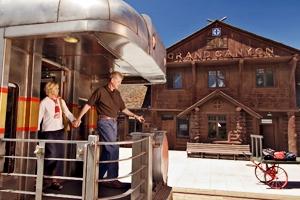Here's an item that, on its face, seems rather non-controversial: Should the one or two trains that roll into Grand Canyon National Park from Williams, Arizona, each day be allowed to continue their operations?
I'm biased, as I love train travel and wish there were more of it available in this country. Nevertheless, park officials are obligated to ask the general public what they think and so for the next 30 days you'll have that opportunity.
That's because Grand Canyon officials recently completed an environmental assessment concerning train operations on the park's South Rim and they're taking public comment on that EA. The document evaluates two alternatives including a no-action alternative. The no-action alternative would continue current train operations, which typically consist of one to two trains from Williams, special-use trains and events, and work trains. Currently, there are no limits on daily trains or special use trains and events under the existing contract.
The action alternative (Preferred Alternative) allows for current operations to continue with a maximum of three trains per day from Williams. The action alternative also allows special use trains, events, and work trains to continue and includes several improvements to the depot.
Special use trains and events would be limited to 30 annually. Work trains would run as needed to maintain the rails and crossings; approximately two work trains per week currently utilize tracks inside the park boundary.
Operational and safety improvements would include installation of ground power to run power to cars while trains are parked at the depot, and possible restoration of tracks 5 and 6, which are currently unused and partially covered with gravel. Additional interpretive opportunities would improve under the action alternative including the possible display of an historic steam engine.
Another alternative was proposed for an excursion train, which would have operated in late afternoon or evening hours. That alternative was considered and dismissed due to its conflict with the purpose and need, and objectives of the project. Specifically, the excursion train is not a historic use of the rail lines and depot. The excursion train does not reduce the number of vehicles entering the park, and finally, the excursion train does not enhance visitor experience or opportunities for interpretation in the park since it travels out of the park to the Apex/Imbleau siding in Kaibab National Forest.
You can review the EA online at this site by clicking on the project name and then scrolling to “Open for Public Comments.” Comments can also be submitted online at the same Web address or mailed to Steve Martin, Superintendent, Grand Canyon National Park, Attention: Train Operations, P.O. Box 129 (1 Village Loop for express mail), Grand Canyon, Arizona 86023. Comments will be accepted through July 29, 2009.
For additional information, contact Rachel Stanton, the park's environmental protection specialist, at (928) 774-9612.




Comments
The ticket price can't be made affordable to everyone unless there is some sort of subsidy. The system -- tracks, rolling stock, etc. -- is privately owned and very expensive to maintain.